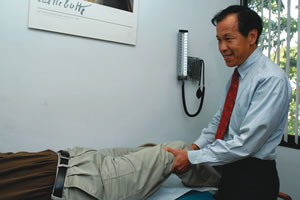
Preventing Running Injuries
April 08, 2009
By Dr. Clifford Lau


Dr. Clifford Lau
Orthopedic Surgeon
Where did you receive your schooling and training?
I’m a local boy from Waipahu High School. I went to UH-Manoa, John A. Burns School of Medicine, and then I went to San Francisco for my orthopedic training. Then I came back to Hawaii to practice.
What are some of the most injuries you see and treat?
We have all kinds of injuries, but basically you get these baby boomers, and many of them are all trying to be athletes, so we see a lot of lower-extremity injuries as well as shoulder injuries. The most common are probably knees and shoulders, and a lot of overuse type of things like strains and sprains. And we also see a lot of things we do arthoscopic surgery on, where people twist their knees or have meniscus tears. These are all things we can fix arthoscopically.
{embed=“elements/box_ad”}
Can you talk about walking and running injuries, and what are the most common injuries you see from those activities?
Since I’m a runner, this area is of particular interest to me. Research finds that more than 50 percent of runners will have some type of injury in their career, and it’s probably from overdoing it. For runners, most of it is training errors and overuse, and the same thing with walkers. So what we see is mainly lower-extremity injuries, mainly knees, ankles and sometimes the hips. A lot of times we’ll have pain in the front of the knee, clicking in the ankles and the hips. A lot of that can be treated with training, stretching, flexibility exercises, ice and anti-inflammatories. When do you need to see a doctor? When the pain starts lasting too long. A little pain during exercise is fine, but if you stop and the pain persists, then that’s the time to go to see a doctor. If you wait too long, then it could be crippling and you could be out of action for a long time.

What are ways to avoid overuse injuries from running?
A good training program - for people interested in perhaps doing a marathon or long-distance running, they should join a clinic. A good training program is to start off slow with rest days, and a lot of stretching, and even some strength-training exercises. And some people have inherent physical limitation or defects, and in those cases, they should see a doctor to see if they need special braces or something for that.
How important is correct running form?
Form makes a big difference, too, and that’s where the running clinics can really help you. Just recently Queen’s and Niketown had a run fitness clinic, and we had a physical therapist there to check functional movement and gait analysis, which will tell you if you’re running too hard or turning a little out. And it makes a difference.
Can you talk about stretching? What’s the right or wrong way of doing it, how important it is in preventing injuries, etc.?
Stretching does play a role. A lot of people don’t stretch. There’s functional stretching that you can do, like walking lunges. If you watch some of the runners, they do high knee lifts and butt kicks, those are ways of stretching. Then after, you’ll stretch your calves and your hamstrings. Usually, do each stretch for a count of 20 - and don’t bounce. Bouncing is the part that will make things wrong. People can overstretch, too, and we’ve actually had people who have torn things because of overstretching. Warming up about 5-10 minutes before you start a strenuous activity, and a warm down, probably 5-10 minutes.
{embed=“elements/google_ad336x280”}
With children, is there an age when parents can start pushing them in regard to physical activity?
Kids are different because their bones are still growing, and that’s the reason we tell parents to hold off on the weight-lifting, strenuous activity and long-distance running. If you look at baseball players, they count the number of pitches they throw because if they pitch too hard, sometimes their growth plate can give way. Most times the growth plate begins to close around 12 or 13. So, at that age, they can start getting a little more active, and by the time they are young adults they can do whatever they want. So, it’s the very young group (5-11) you don’t want to push very hard.